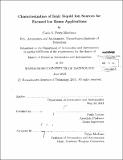Characterization of ionic liquid ion sources for focused ion beam applications
Author(s)
Perez Martinez, Carla S. (Carla Sofia)
DownloadFull printable version (10.96Mb)
Other Contributors
Massachusetts Institute of Technology. Department of Aeronautics and Astronautics.
Advisor
Paulo Lozano.
Terms of use
Metadata
Show full item recordAbstract
In the Focused Ion Beam (FIB) technique, a beam of ions is reduced to nanometer dimensions using dedicated optics and directed to a substrate for patterning. This technique is widely used in micro- and nanofabrication for etching, material deposition, microscopy, and chemical surface analysis. Traditionally, ions from metals or noble gases have been used for FIB, but it may be possible to diversify FIB applications by using ionic liquids. In this work, we characterize properties of an ionic liquid ion source (ILIS) relevant for FIB and recommend strategies for FIB implementation. To install ILIS in FIB, it is necessary to demonstrate single beam emission, free of neutral particles. Beams from ILIS contain a fraction of neutral particles, which could be detrimental for FIB as they are not manipulated by ion optics and could lead to undesired sample modification. We estimate the neutral particle fraction in the beam via retarding potential analysis, and use a beam visualization tool to determine that most of the neutral population is located at the center of the beam; the neutral population might then be eliminated using filtering. The same instrument is used to determine the transition of the source from single to multiple beam emission as the extraction voltage is increased. These studies should guide in the design of the optical columns for an ILIS-based FIB.
Description
Thesis (S.M.)--Massachusetts Institute of Technology, Dept. of Aeronautics and Astronautics, 2013. This thesis was scanned as part of an electronic thesis pilot project. Cataloged from PDF version of thesis. Includes bibliographical references (p. 79-82).
Date issued
2013Department
Massachusetts Institute of Technology. Department of Aeronautics and AstronauticsPublisher
Massachusetts Institute of Technology
Keywords
Aeronautics and Astronautics.